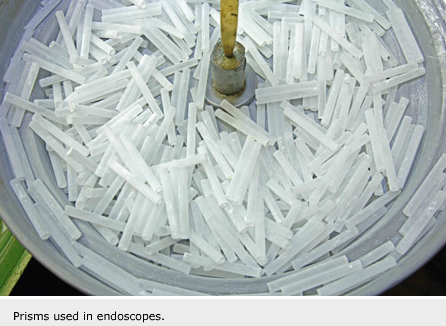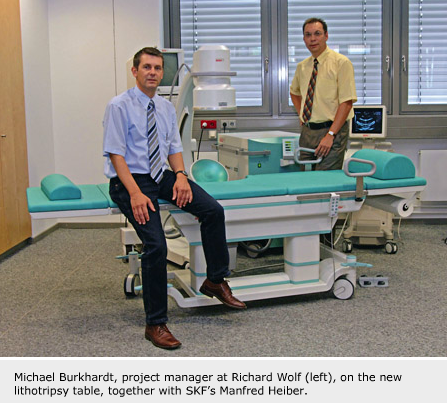Design in the service of medicine
At Richard Wolf GmbH, design plays an important role in creating medical instruments and systems that improve conditions in the operating room.
At Richard Wolf GmbH, design plays an important role in creating medical instruments and systems that improve conditions in the operating room.
When you walkinto the demonstration room at Richard Wolf GmbH, the first thing that catches your eye is a cream-and-aquamarine-coloured table, a piece of furniture whose soothing colours and graceful curves would fit in well at a health resort. This table, however, is designed for use in hospitals and clinics. It’s part of a complete system using a patented shock-wave device to pulverize kidney stones and gallstones and to relieve pain for symptoms such as tennis elbow.
“Design is the key here,” says Michael Burkhardt, Richard Wolf’s project manager for the table, which is being manufactured by SKF. “You don’t want to arouse fear in the patient when he or she comes in for treatment. And avoiding fear also reduces pain for the patient.”
Design is one of the ways that Richard Wolf differentiates itself in the medical supplies market, which has grown more competitive in recent years. Another element that enables Richard Wolf, a German medium-sized company situated in Knittlingen near Karlsruhe, to stay abreast of the competition is continuous innovation, including the development of complete systems for operating rooms. And finally, a tradition of strict quality management at this company, starting at its inception in 1947, to make sure that customers keep coming back.
Peter Vallon, head of lithotripter sales and marketing, says the company is currently expanding into new markets, including the United States and China. The stone-smashing or lithotripsy treatment system manufactured by Richard Wolf was designed to meet requirements in the US market, which Richard Wolf entered in 2004. A year later, says Vallon, Richard Wolf was completing the approval process for its medical equipment in China, paving the way for growth in that market. The company is already well represented in Japan, with more than 30 lithotripsy systems in hospitals there, and is a market leader worldwide in piezoelectric lithotripsy systems. Richard Wolf has more than 1,300 employees, and some 100 offices represent the company internationally.
Perhaps the best-knownof Richard Wolf’s innovations is its line of piezolith devices for crushing stones in the body. This system, introduced in 1986, was the first of its kind to include an inline ultrasound locator, enabling caregivers to crush stones without anaesthesia. Later versions incorporate X-ray location as well and provide more flexibility in helping medical personnel locate and focus on the stones to be pulverized with a series of shock waves. The latest version, the Piezolith 3000, includes two layers of ceramic cylinders that produce the shock waves, thereby increasing the range of therapy intensity.
Compared with other lithotripsy systems, the Piezolith offers advantages both for patients and for the medical facilities that treat them. On the one hand, the greater precision afforded by the Piezolith system reduces the potential for internal bleeding and pain in patients, and the range of uses is greater – the piezoelectric system is the first to pulverize salivary stones, and the smallest piezoelectric devices can be used for pain therapy in joints and muscles. On the other hand, hospitals get more years of use out of a Piezolith system, Burkhardt says, explaining that a system using electromagnetic energy can produce about 1 million shock waves in all, whereas the Piezolith can provide more than 5 million shock waves before it needs replacement.
One of the very latest innovations at Richard Wolf, a high-speed camera introduced in 2005, is designed for use in the medical field of ENT (ear, nose and throat medicine). This device, which sets a new standard worldwide, produces 4,000 images per second of a patient’s vocal cords, compared with a standard of 25 pictures per second in older systems. That opens up new possibilities in diagnosis, as doctors can for the first time observe the vibrations of the vocal cords in slow motion at each stage of their movement, says Uwe Spitzmueller, manager for product training and coaching.
“We have to constantly come closer to perfection – get faster, cheaper and smaller,” adds Burkhardt. “The competition is extremely tough.”
Aside from conceptualizingnew products, Richard Wolf has in recent years focused on providing customers with complete systems for the operating room. Aside from the Piezolith systems, Richard Wolf also offers what it calls the CORE, or “complete operating room endoscopy,” which includes everything from an operating table and a pump for keeping the abdomen open, to a touch-screen monitor for updating information, and two monitors on which doctors and nurses can view the surgery site. Complete systems such as this have become more important at hospitals throughout the world, Spitzmueller says, as purchasing has been subject to cost controls and greater financial oversight than in the days when chief physicians made all purchasing decisions.
Regular contact with doctors and hospitals through pilot projects at associated clinics makes sure that Richard Wolf stays in tune with the changing needs of doctors and the ever-increasing demands for precision and reduction in the size of instruments. Other factors that help Richard Wolf stay competitive are its commitment to quality and its pride in its reputation in the industry. Whether in complete systems or individual products, design helps differentiate products both visually and in their ease of use – and it sets Richard Wolf apart in its field. In 2004, the company received the iF design award from the Industrie Forum Design centrein Hannover, comparable to an Oscar for films, for its new generation of flexible endoscopes. Richard Wolf prevailed in a field of nearly 2,000 entries from more than 30 countries, with the international jury praising the ergonomics and the design of the company’s endoscopes.
Back in his demonstration hall, Burkhardt points out the design elements that distinguish the aquamarine-and-cream-coloured lithotripsy system from the CORE, where red lines accentuate the spare functionality of the grey metal equipment. “On a scale of one to 10, the importance of design comes in somewhere between eight and 10,” says Burkhardt. “You need more than just a techno-logically superior product to succeed in the market today. Aside from the technology, the design must be outstanding.”
A FAST DELIVERY
SKF won the contract for Richard Wolf’s new lithotripsy table, says Richard Wolf project manager Michael Burkhardt, because SKF could deliver the product faster than anyone else. That was important to Richard Wolf, which needs the table to meet the needs of one of its newest markets, the United States. As a bonus, the new table offers greater flexibility in moving the patient.
For SKF, meanwhile, the project represented a new challenge for sales engineer Manfred Heiber, who in a departure from the norm, accompanied the project from conception to completion. Heiber played a more comprehensive role than usual because of the need for close coordination – not only with Richard Wolf, which specified the technical parameters, but also with an outside design office, which created an eye-pleasing exterior for SKF’s basic prototype.
“This was certainly a lot of fun to work on, and a new challenge, with all of the technical work,” says Heiber. “The table represents a new direction for us, as until now we have focused on supplying parts rather than complete products in this market. We hope to do more of this in the future.”
SKF components for Richard Wolf’s lithotripsy table, the Comfort Stretcher, include lifting columns, linear drives and rail guides for X and Y movements.






